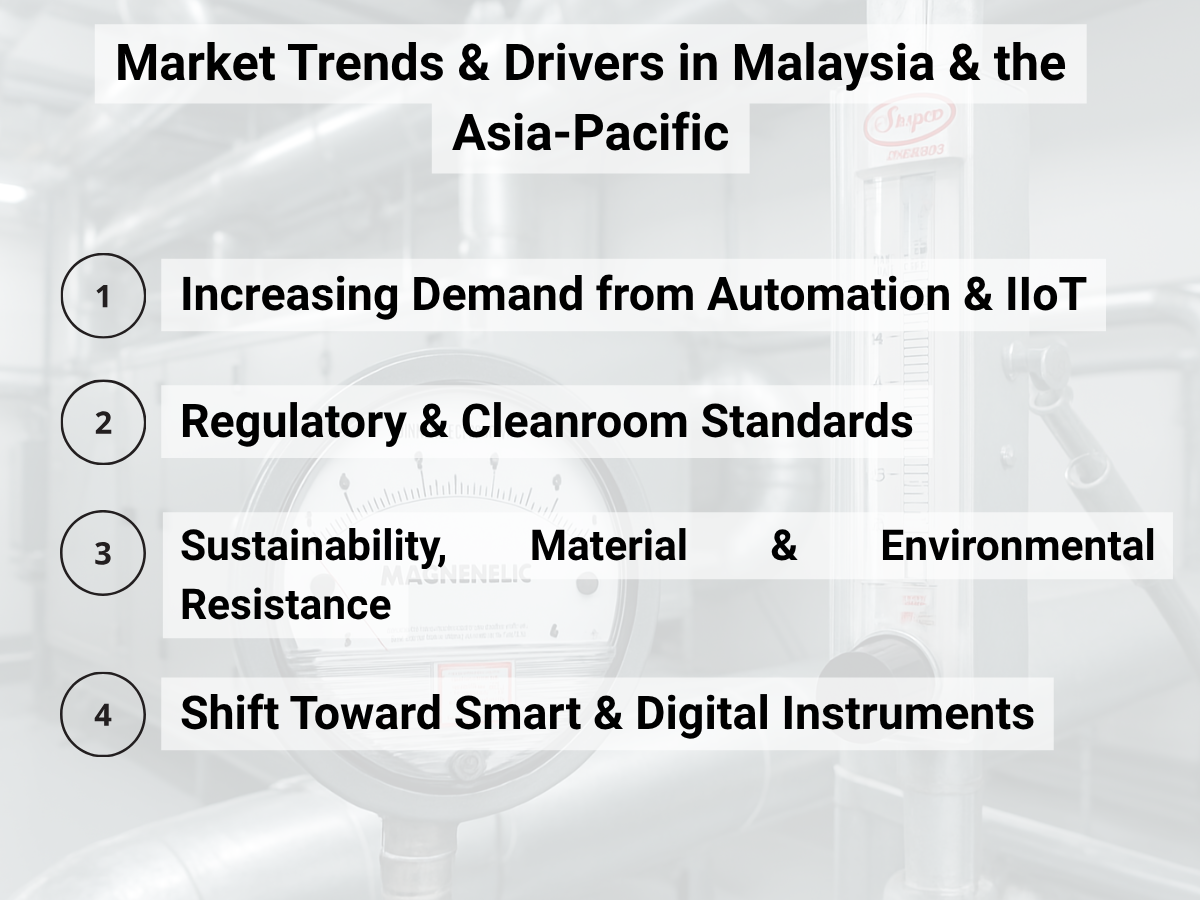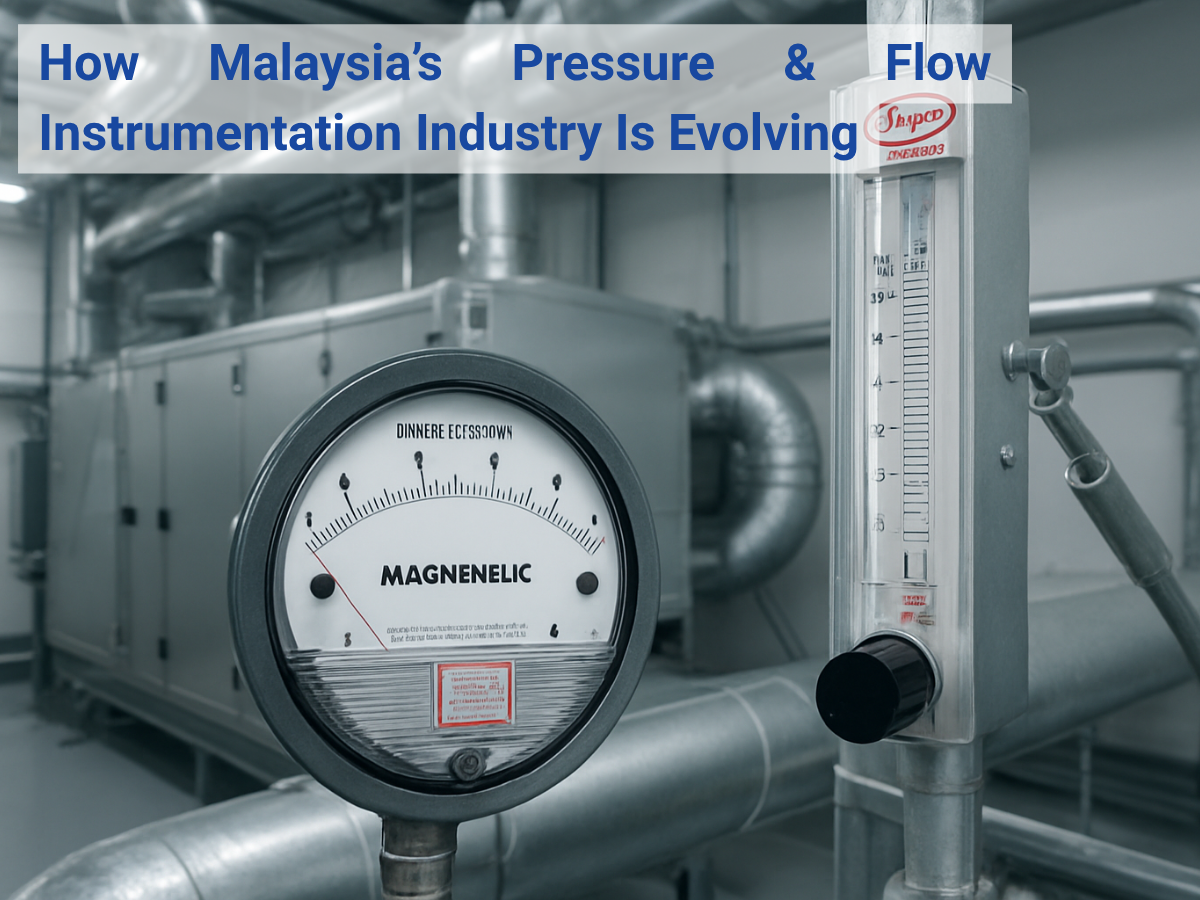How Malaysia’s Pressure & Flow Instrumentation Industry Is Evolving
Instrumentation is no longer just “read a gauge and move on.” In Malaysia, evolving industries, stricter regulatory requirements, and automation are pushing measurement solutions toward greater precision, connectivity, and resilience. Dwyer / DwyerOmega remains a leader, especially where differential pressure, flowmeters, switches, and manometers are required. In this post, we go deeper: market/trend drivers, technical innovations, detailed applications, case-scenarios, and how Wintech Engineering is positioned to deliver.

Market Trends & Drivers in Malaysia & the Asia-Pacific
- Increasing Demand from Automation & IIoT
-
- Across Asia-Pacific, the differential pressure transmitter market is growing strongly, driven by industries automating more of their process, leveraging remote monitoring, predictive maintenance.
- Malaysian industries (oil & gas, water/wastewater, food & beverage, pharmaceuticals) are under pressure to reduce downtime, improve compliance, and collect more data, this favors digital and smart instrumentation.
- Regulatory & Cleanroom Standards
-
- Cleanroom certification (ISO 14644), GMP – pharmaceutical, and environmental standards mean more stringent requirements on maintaining pressure differentials, monitoring filter integrity, detecting leaks.
- Energy efficiency regulations (e.g. the need to reduce fan/pump power) encourage better measurement of static pressures and flow so systems can be optimized.
- Sustainability, Material & Environmental Resistance
-
- Instruments must withstand tropical humidity, temperature swings, climatic cycles, and corrosion. Products built with IP ratings, corrosion resistant materials, and protective coatings are more in demand.
- Also, the push toward low maintenance, long lifespan, fewer repairs.
- Shift Toward Smart & Digital Instruments
-
- Integration of sensors with digital or remote outputs (4-20 mA, HART, wireless) so that measurement data can feed into Building Management Systems (BMS) or SCADA.
- Devices that combine multiple parameters: for example, flowmeters that also measure temperature/pressure, or differential pressure instruments with alarm/switching capability.
Technical Advances & Product Innovation from Dwyer
Digital Flow Meters & Mass Flow Technology
- Dwyer’s DFM series (Digital Flow Meter) supports multi-gas functionality, fast response times (<20 ms), configurable outputs, simultaneous display of flow, temperature, pressure. Useful where process gas composition or conditions vary.
- These advances matter in Malaysian process applications (e.g. chemical plants, labs) where gas mixtures change, and correction for temperature/pressure is needed.
Variable-Area & Visi-Float Flowmeters
- The traditional variable-area flowmeters (such as Rate-Master® and Visi-Float® series) are still very relevant when you need simple, visual, low complexity flow indication. Advantages: no external power needed (for analog units), ease of maintenance.
- For example, Dwyer’s Rate-Master RM / RMA / RMB / RMC flowmeters in Malaysia are used in water / air flow measurement in both lab and industrial plant settings.
Differential Pressure Gauges, Switch-Gauges, and Hybrid Units
- Photohelic® units: pressure gauge + switch in the same instrument. Good where you want to monitor differential pressure and also trigger alarms or control extractors / fans / valves.
- Magnehelic® gauges remain a mainstay for cleanrooms, HVAC filter monitoring, duct static pressure readings, mechanical, simple, rugged, and trusted.
Mass Flow Controllers & Gas Flow Devices
- For applications involving gas flow with tight control (e.g. semiconductor, lab processes, gas purging), Dwyer’s gas mass flow meters (GFM series) provide high accuracy, relay outputs, digital communications, and programmability.
Key Applications & Case Scenarios in Malaysia
Let’s look at more detailed examples of how Dwyer instrumentation is (or could be) applied in real Malaysian industry settings.
Ø Case Scenario 1 – Pharmaceutical / Biotech Cleanrooms
- Requirement: Maintain pressure differential between cleanroom zones (e.g. 4 vs 7 vs 9 air changes), monitor filter condition, ensure no ingress of contaminant.
- Solution: Use Magnehelic or digital differential pressure gauges between rooms and corridors; Photohelic switches to alert when pressure drops below thresholds; regular calibration via local supplier.
Ø Case Scenario 2 – Palm Oil Processing & Agro-Industrial
- Steam boilers, filter presses, gas burners, ventilation systems. Ensuring proper airflow in digesters, pressure drop across filters, safe exhaust of flue gases.
- Use of flowmeters (variable area or mass flow) to monitor air/gas flows, differential pressure across bag filters, manometers for simpler checks.
Ø Case Scenario 3 – Water Treatment & Utilities
- In treatment plants: monitoring water flow, pressure drop in membranes, control of chemical dosing.
- Multi-jet water meters (such as Dwyer’s WMT2 series) used for measuring total flows with pulse outputs for integration into monitoring systems.
Choosing the Right Dwyer Solution: Detailed Criteria
Here’s a more expanded guide to help specifiers, engineers, purchasers in Malaysia choose the right Dwyer instrumentation.
| Decision Factor | Key Technical Considerations | Local Malaysian Conditions / Tests |
| Measurement Range & Span | Avoid undersizing the span (less resolution) or oversizing (wasted sensitivity). Consider minimum and maximum expected differential pressures / flow rates. | Account for temperature variations (tropical heat), seasonal variations in humidity / gas density. |
| Accuracy & Repeatability | Check % full-scale error, hysteresis, response time. Digital units are often better for these parameters. | Ensure calibration traceable to recognized standards (local calibration labs). |
| Material & Corrosion Resistance | Wetted parts, body materials: stainless steel, polycarbonate, PVC, or more exotic materials depending on chemical exposure. | High humidity, exposure to corrosives (e.g. salt air in coastal industrial zones) must be considered. |
| Power / Output Type | Analog (4-20 mA), voltage, relay/switch, digital communications like RS-485, HART. Hybrid (gauge + switch). | In many cases power availability, wiring complexity, maintenance access matter. Wireless solutions can help with difficult access. |
| Environmental Protection | IP rating, vibration resistance, temperature / humidity extremes. | Malaysia can have high heat, rainfall, tropical storms; outdoor mounting, rooftop AHUs, and exposed pipe runs need high IP protection. |
| Maintenance, Calibration & After-Sales Support | Availability of spare parts, ease of cleaning, local calibration service, ability to re-scale or recalibrate easily. | Choosing an authorized distributor like Wintech ensures shorter lead times, access to genuine parts, calibration locally. |
| Cost of Ownership | Not just purchase price, factor energy/maintenance, downtime, spare parts, calibration. | More rugged instruments that last longer may cost more initially but save over lifetime. |
Future Outlook & Innovation Opportunities
- Wireless & Remote Monitoring: Increasing trend toward field-remote transmitters and sensors with wireless communication. Useful for plants with dispersed equipment.
- Smart Analytics & Predictive Maintenance: Using the data from Dwyer instruments (flow, differential pressure, filter alarms) to predict failures, optimize filter or equipment replacement.
- Compact, Multi-Parameter Devices: Units that measure flow + temperature + pressure in one device reduce installation cost and wiring.
- Materials Engineering: Enhanced materials to resist biofouling, corrosion, UV exposure. More rugged sealings / protective housings.
- Sustainability & Energy Saving: Better fan/pump efficiency via better pressure/flow balancing; leak detection; reduction of over-pressure or over-sizing.
- Regulatory & Compliance Evolutions: More stringent energy, environment and safety regulations may demand more accurate and traceable instruments, certified for standards like ISO, maybe even local Malaysian regulatory requirements.
How Wintech Engineering Enhances Value for Malaysian Customers
Wintech Engineering is uniquely positioned to bring together these market trends and technical advances and deliver value:
- Local Expertise: Understanding local climatic, regulatory, and industrial conditions so that solutions are fit for purpose.
- Offer More than Just Products: Consultation, helping clients specify the right instrument, panel mounting, snapping in accessory kits.
- Calibration & After-Sales: Ensuring instruments stay accurate over their life; managing spare parts, providing service.
- Stocking Smart & Digital, Not Just Legacy Models: Ensuring they carry both analog/traditional (Magnehelic, variable area flowmeters) and modern digital or hybrid models.
- Training & Support: Educating client teams on reading, installing, maintaining instruments properly, preventing measurement errors, prolong life.
Frequently Asked Questions (FAQs)
What is the difference between analog differential pressure gauges (e.g. Magnehelic) and digital transmitters?
Analog gauges are mechanical, simple, robust, with no need for power; best for visual inspection or non-critical functions. Digital transmitters offer outputs for remote monitoring, alarms, data logging, more precision and flexibility (e.g. programmable display, multiple units).
Can Dwyer instruments handle very low differential pressures?
Yes, certain models are designed for low differential pressure ranges, especially for cleanroom or lab environments. Choosing a gauge/transmitter with appropriate sensitivity and a range that aligns to the smallest differential you need is essential.
What output types are available, and how do they affect integration with BMS / SCADA?
Many units provide 4-20 mA, analog voltage, or relay/switch outputs; more advanced / newer sensors offer digital communications (RS-485, HART). For integrating into BMS/SCADA, ensure compatible output and proper wiring, calibration, signal quality.
How do environmental factors in Malaysia (humidity, temperature, dust) affect instrument performance and lifespan?
High humidity and temperature can affect materials (causing corrosion, seal deterioration), and cause condensation. Dust and particulate matter can block vents, filters in the instruments. To mitigate: choose IP rated housings, corrosion resistant materials, regular cleaning and proper installation (e.g. shade or shelter for outdoor units).
Conclusion
Dwyer instrumentation continues to evolve, not just in product technology but in how measurement is integrated into modern smart systems. In Malaysia, industries are converging around higher precision, better environmental resistance, lower maintenance, and more connectivity.
For companies seeking reliable, long-term performance, the choice lies in selecting the right instruments, understanding the local environment, leveraging digital capabilities, and working with partners who provide full support, such as Wintech Engineering Malaysia.


